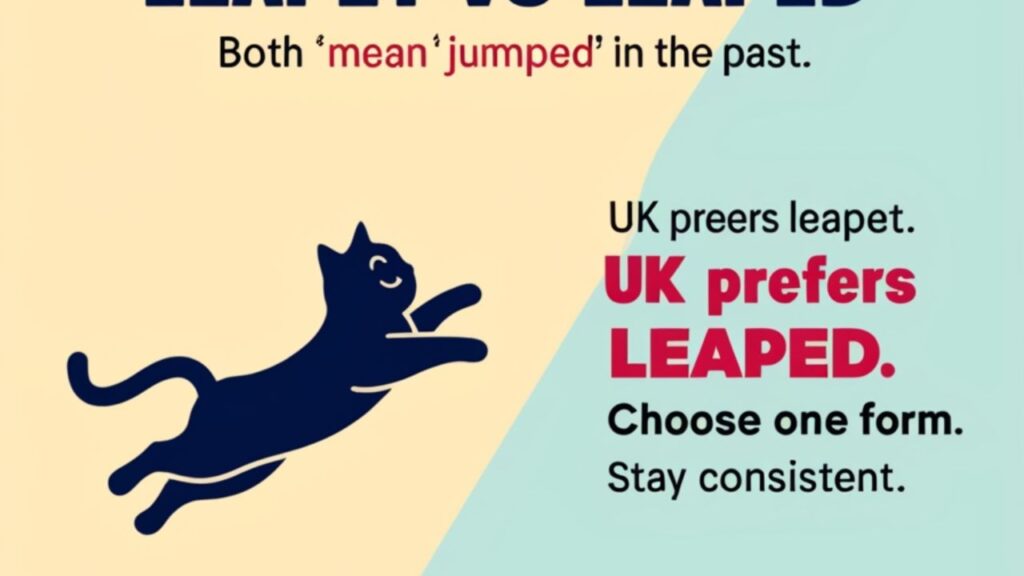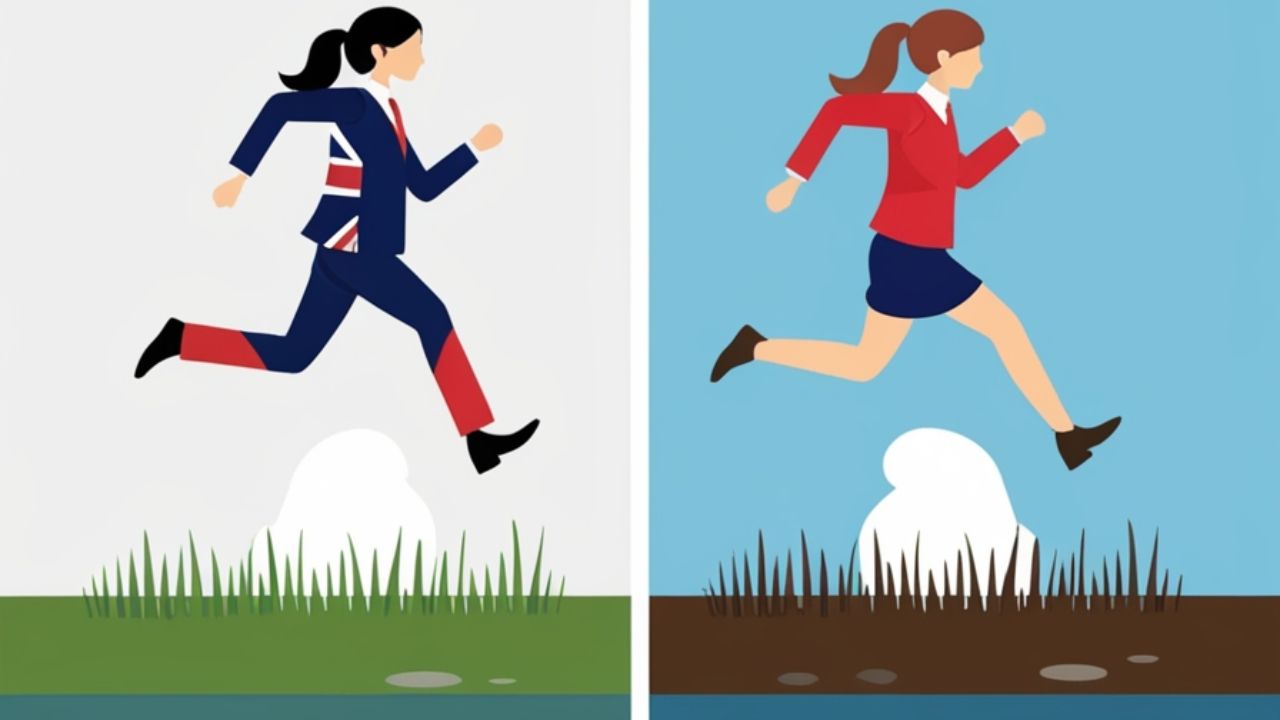Leapt vs Leaped: Key Grammar Difference Explained clarifies two simple choices. Both words mean jumped in the past. Writers use leapt or leaped for the same action. You can choose either form. Keep your choice steady in one piece of writing.
Readers in British English often prefer leapt. Readers in American English often prefer leaped. Both choices sound fine. Pick the form that fits your audience. Use short sentences for young learners. Clear words help them read and learn.
Match your tone to the task. Stories and poems may welcome leapt. School notes and news often use leaped. Stay consistent across the page. Keep examples simple. For instance, write He leaped over a puddle or The kitten leapt onto the chair.
Quick Look: Leapt vs. Leaped – What’s the Difference?
| Feature | Leapt | Leaped |
| Verb Form | Past tense and past participle (irregular) | Past tense and past participle (regular) |
| Region | Preferred in British English | Preferred in American English |
| Tone | Slightly formal or poetic | More conversational and modern |
| Frequency (Global) | Less common than “leaped” globally | More widely used worldwide |
| Usage in Writing | Common in literature and the British media | Common in everyday writing, journalism, and American media |
What Is the Past Tense of “Leap”?
In simple grammar, the past tense of leap has two correct forms. Writers use leapt and leaped to show a jump already happened. Both choices work in class notes and stories. Choose one form for your page, then keep that choice throughout.
In British English, many writers prefer leapt for formal tone and literature. In American English, many writers prefer leaped for clear, everyday writing. Match your audience. Use short examples like, He leaped over the puddle. Or, The kitten leapt onto the chair.
- The verb leap has two correct past tense forms: leapt and leaped. Both forms show a jump already happened and also work as past participles.
- British English prefers leapt in formal writing and stories. American English prefers leaped in everyday notes and school work.
- Choose one form for your page and keep it steady. Match the form to your readers. For example, He leaped over the puddle. The cat leapt onto the chair.
See also : Booze vs Boos: Meaning, Usage & Common Mistakes
Historical Roots and Etymology
Etymology gives the story of words. The verb leap comes from Old English “hlēapan,” meaning jump or spring. Early writers shaped strong past forms. Poets favored sound and rhythm. Scribes recorded patterns. Over time, both leapt and leaped stayed in everyday use.
History also shows regional habits. British English often keeps leapt for literature and tradition. American English often prefers leaped for lessons and news. Schools teach stable models. Editors guide choices. You choose one form, then keep it consistent.
Usage Trends: What Do People Say and Write?

- In American English, writers often use leaped in school work and news. It feels simple and clear for everyday sentences.
- In British English, writers often choose leapt in stories and formal pieces. It keeps a traditional sound many readers enjoy.
- Usage data shows steady growth for leaped in the US over time. Leapt remains common in UK literature and classroom guides.
Regional Differences: US vs UK
Writers in the United States often choose leaped in school books, newspapers, and everyday notes. Writers in the United Kingdom often choose leapt in stories and formal pieces. Both forms work. You select one form that suits your reader and purpose.
Editors in American English prefer clear, simple rhythms, so leaped fits many sentences. Editors in British English value tradition and poetic sound, so leapt often feels right. Keep your choice steady across the page. Consistency helps young learners build trust.
| Region | Preference | Common Contexts | Example Sentences |
| United States | Leaped | Every day writing, media, spoken language | “She leaped over the fence with ease.” |
| United Kingdom | Leapt | Formal writing, literature,and poetry | “He leapt onto the stage without hesitation.” |
Tone, Style, and Rhythm: How Writers Choose
- Writers choose forms to fit tone, audience, and purpose. Leapt gives a gentle, poetic feel. Leaped sounds plain and clear.
- Sentence rhythm guides the pick. Leapt creates tighter beats in short lines. Leaped keeps even pacing in classroom notes.
- Match style to region and genre. In British English, stories often use leapt. In American English, school work often uses leaped. Consistent choice keeps reading smooth.
Context Matters: When to Use “Leapt” or “Leaped”
- Match your audience and region. In American English, use leaped for school work and news. In British English, use leapt for stories and formal notes.
- Adjust to register and genre. Choose leapt for poetic scenes or classic tone. Choose leaped for clear, direct instruction.
- Listen to rhythm in nearby words. Pick the form that reads smoothly. Keep one choice through the page so young readers build steady understanding.
Examples in Context
In a quiet story, a writer may choose leapt to shape a calm, graceful beat. The cat leapt to the sill. The boy leapt across the stream. These lines suit British English tone. The rhythm feels soft, steady, and slightly traditional.
For classroom notes, a teacher may choose leaped for clear flow. The cat leaped onto the table. The runner leaped over the cones. These lines suit American English style. Keep one form through the page. Consistent choice supports young readers.
Consistency in Your Writing: Why It Matters
Consistency keeps your writing clear and calm. Choose leapt or leaped once, then use that choice everywhere. Readers follow your pattern with ease. Teachers value neat work and steady rules. Consistent forms reduce mistakes. Your page looks tidy and your message stays strong.
Set a plan before you start. Pick a style guide or classroom rule and write it at the top. For British English you may select leapt. For American English you may select leaped. Use find and replace. Read aloud. Check once more.
- Choose consistency before you write. Pick leapt or leaped once. Keep that form in titles, captions, and sentences. Your pages look tidy. Young readers follow patterns with ease. Teachers see careful work and steady habits.
- Set a simple style guide. For British English, select leapt. For American English, select leaped. Write the rule at the top. Check drafts against the rule. Small checks prevent slip-ups.
- Use tools that support consistency. Run find-and-replace for the other form. Read aloud to catch stray switches. Mark tricky pages with a note. Finish with one clean pattern across the workbook.
Writer’s Toolkit: Alternatives to “Leapt” and “Leaped”

Build a simple toolkit with strong action verbs. Choose jumped, bounded, or vaulted when you want clear pictures. Use short examples like, The dog bounded across grass. The athlete vaulted the rail. These choices add energy and keep sentences crisp.
Match words to meaning and rhythm. Select sprang for sudden motion. Pick hopped for light steps. Use jumped for general actions. Read the line aloud. Keep one form through the page. Clear choices support young readers and steady learning.
Common Mistakes and Misconceptions
- Thinking one form is wrong creates trouble. Both leapt and leaped work. Match your choice to British English or American English. Keep the choice steady across the page for clear reading.
- Switching forms in one lesson confuses young readers. Set a simple consistency rule. Use one form in titles, notes, and examples. Finish with the same form in every line.
- Forcing a formal tone causes stiff lines. Leapt suits stories and poems. Leaped suits class notes and news. Read the sentence aloud. Choose the word that sounds smooth and natural.
See also : Content vs Contented: Key Meanings and Usage Tips
Final Thoughts
Finish with clear guidance. Choose leapt or leaped for your audience and tone. Follow a style guide from the first line. Keep sentences short and steady. Use simple examples for young readers. Maintain one pattern across the page to build understanding.
Strong writing grows through small habits. Read aloud and check once more. Match words to purpose in British English or American English. Replace repeats with fresh verbs. Guide students with calm steps. Keep choices consistent so learners trust the page.
Resources for Further Study
- Visit Cambridge Dictionary and Merriam-Webster for clear meanings, forms, and audio. Check example sentences and notes on British English and American English usage. https://dictionary.cambridge.org/ • https://www.merriam-webster.com/
- Read Oxford Learner’s Dictionaries guidance and the Chicago Manual of Style for consistent choices in school work and reports. Follow simple rules and keep one form throughout. https://www.oxfordlearnersdictionaries.com/ • https://www.chicagomanualofstyle.org/
- Explore Google Ngram Viewer trends and BBC Learning English lessons for real-world usage and gentle practice. Compare lines from books and news. Build steady habits with short review sessions. https://books.google.com/ngrams • https://www.bbc.co.uk/learningenglish
Summary Table: When to Use “Leapt” or “Leaped”
| Factor | Use “Leapt” | Use “Leaped” |
| Region | UK and Commonwealth countries | USA and Canada |
| Style | Formal, literary, poetic | Informal, modern, conversational |
| Audience | Readers expecting traditional usage | Readers preferring clear, modern usage |
| Writing type | Novels, poetry, and classical writing | Journalism, blogs, and casual writing |
FAQs
Should I use leaped or leapt?
Both are correct. “Leaped” is more common in American English, while “leapt” sounds slightly more formal or poetic.
Is it leapt or leaped in Canada?
Canadians use both, but “leapt” is slightly more common due to British influence in Canadian English.
Is it leapt or leaped in the UK?
In the UK, “leapt” is preferred and considered the traditional or standard past tense of “leap.”
Is it leaped or left?
“Leaped” is the past tense of “leap,” meaning jumped. “Left” is the past tense of “leave,” meaning departed.

Join Bibcia on a journey to master English grammar. Discover easy lessons, writing tips, and practical examples designed to make learning grammar simple and effective.










